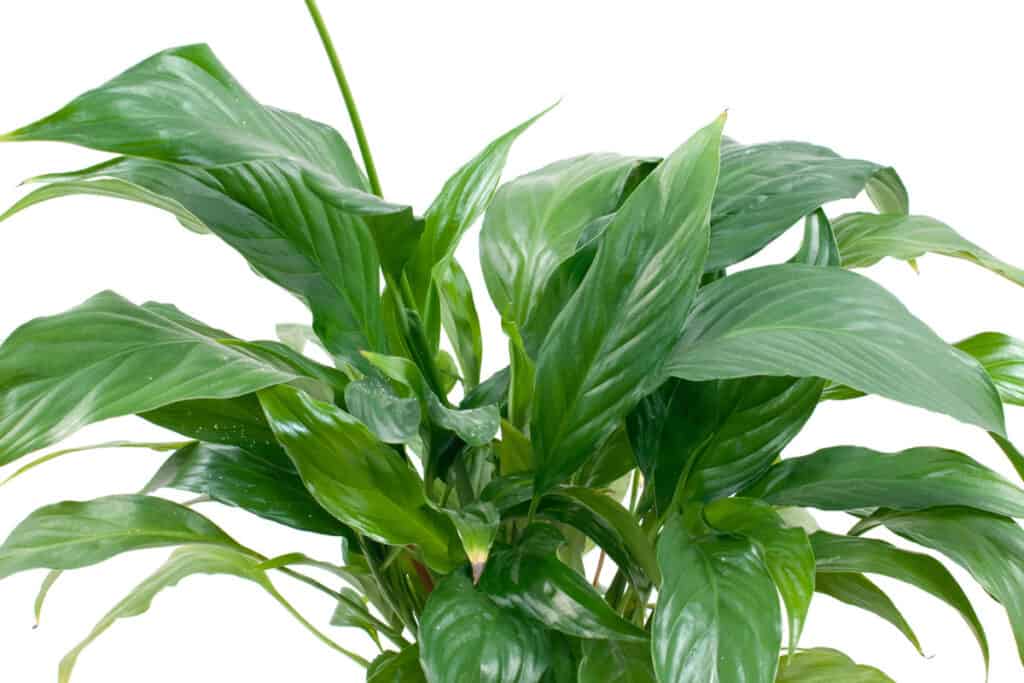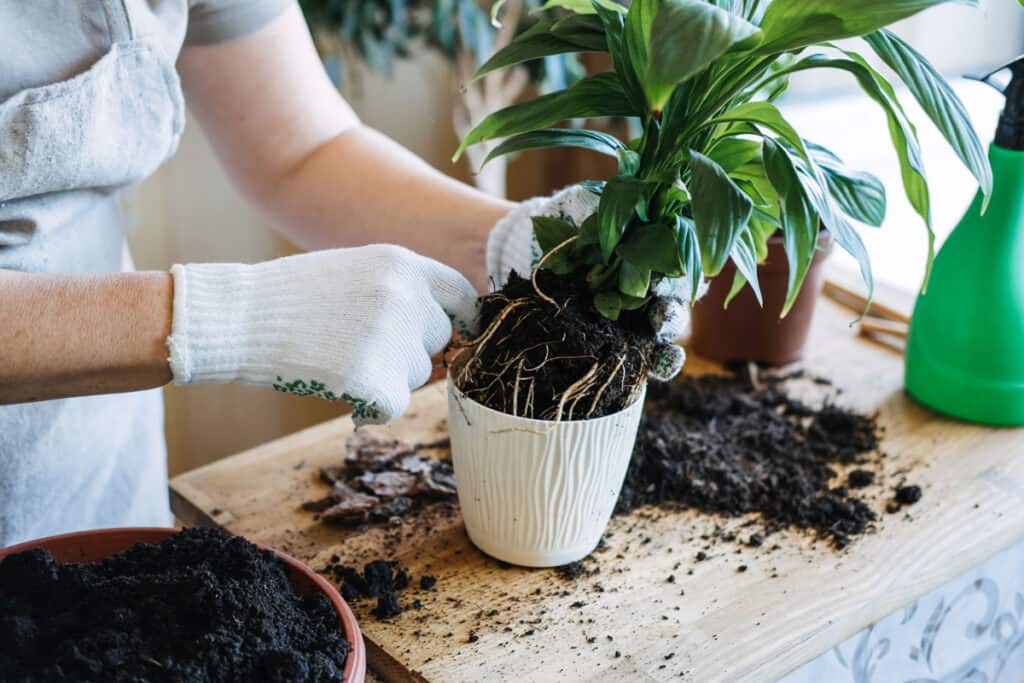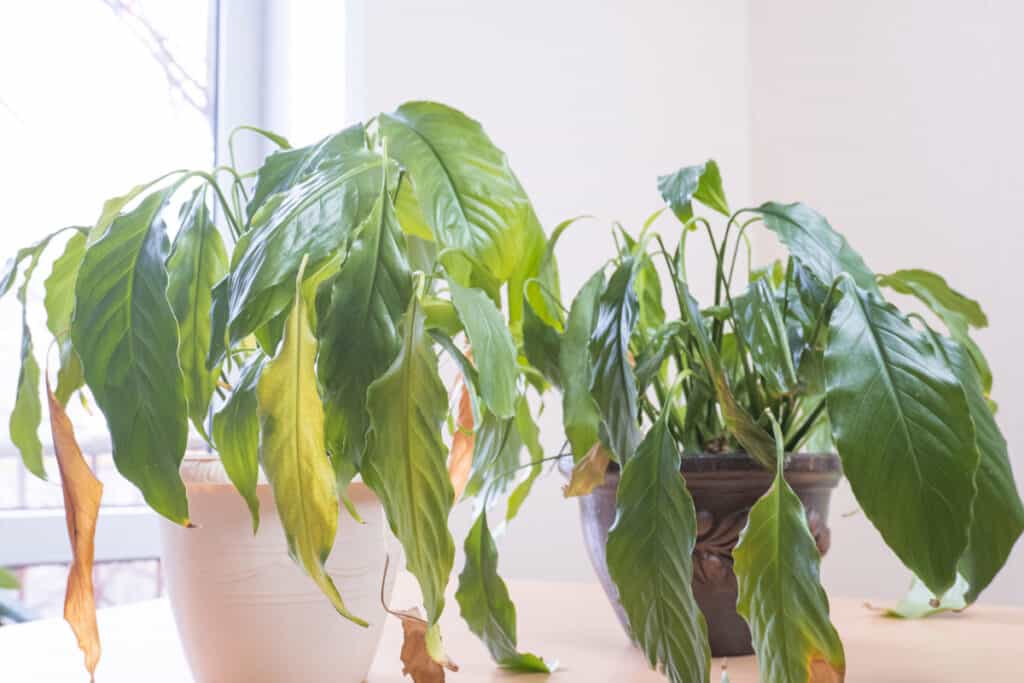Peace lily leaves curling is a common issue among plant owners. This beautiful plant, also known as Spathiphyllum, is a popular houseplant due to its lush green leaves and delicate white flowers. However, when the leaves start to curl, it can be a sign that something is wrong with the plant. In this blog post, we will explore the reasons why peace lily leaves may be curling and what you can do to fix the problem. Whether you’re a seasoned plant enthusiast or a new plant parent, this information will help you keep your peace lily healthy and beautiful.

Contents
- 1 9 Causes Of Peace Lily Leaves Curling
- 2 Frequently Asked Questions
- 2.1 What does an overwatered peace lily look like?
- 2.2 Can a peace lily recover from overwatering?
- 2.3 How do I know if my peace lily needs water?
- 2.4 How often should you water a peace lily?
- 2.5 Should you let a peace lily dry out before watering?
- 2.6 Should I spray water on my peace lily?
- 2.7 Can leaf curl be cured?
- 2.8 Does neem oil help with leaf curl?
- 3 Conclusion
9 Causes Of Peace Lily Leaves Curling
1. Excessive light
Peace lilies prefer bright, indirect light, but too much direct sunlight can cause the leaves to curl. The chlorophyll in the leaves can break down when exposed to too much light, leading to discoloration and curling.
If the peace lily leaves are curling due to excessive light, move the plant to an area with bright, indirect light. Avoid placing the plant in direct sunlight as this can cause the leaves to curl and discolor.
2. Improper watering
Both under-watering and over-watering can cause the leaves to curl. Under-watering can cause the leaves to dry out and curl, while over-watering can lead to root rot and cause the leaves to curl and turn yellow.
To fix peace lily leaves curling due to improper watering, it is important to establish a regular watering schedule. Allow the top inch of soil to dry out before watering again. If the leaves are curling due to under-watering, increase the frequency of watering, if the leaves are curling due to over-watering, reduce the frequency of watering.
3. Water quality
Peace lilies are sensitive to chlorine and fluoride, which can be found in tap water. These chemicals can cause the leaves to curl and brown.
To fix peace lily leaves curling due to water quality, use filtered or distilled water to avoid chlorine and fluoride.
4. Temperature stress
Peace lilies prefer a consistent temperature between 60-90F (15-32C), and sudden changes can cause the leaves to curl. Cold drafts or hot air can cause the leaves to wilt and curl.
To fix peace lily leaves curling due to temperature stress, keep the plant away from cold drafts or hot air. Keep the temperature in the room consistent between 60-90F (15-32C).
5. Low humidity
Peace lilies prefer a humid environment, and dry air can cause the leaves to curl. This is particularly common in winter when the air is dry due to heating systems.
To fix peace lily leaves curling due to low humidity, increase the humidity around the plant by placing a tray of water near the plant, or use a humidifier.
6. Poor soil drainage
Peace lilies require well-draining soil, and if the soil is too heavy or compacted, it can retain too much water, causing the roots to rot and the leaves to curl.
To fix peace lily leaves curling due to poor soil drainage, repot the plant into a well-draining potting mix and ensure that the pot has drainage holes.
7. Nutrient deficiency
A deficiency in essential nutrients like nitrogen and potassium can cause the leaves to curl and turn yellow.
To fix peace lily leaves curling due to a nutrient deficiency, fertilize the plant with a balanced, water-soluble fertilizer.
Related Post:
Do Peace Lilies Like Coffee Grounds? (Benefits & Risks)
8. Overcrowded pot
Overcrowding can cause the peace lily to compete for resources like water, light, and nutrients, and can result in curling leaves.
To fix peace lily leaves curling due to an overcrowded pot, repot the plant into a larger pot and ensure that the plant has enough room to grow.

9. Pests
Pests like aphids, mealybugs, spider mites, and thrips can all cause leaf curling. They suck the sap from the leaves, causing them to curl and discolor. Fungal or bacterial infections can also cause leaf curling and discoloration.
To fix peace lily leaves curling due to pests, inspect the plant regularly and remove any pests by hand or use an insecticide. If the problem persists, consider consulting with a professional or bringing a sample of the plant to a nursery or garden center for identification and advice.
Frequently Asked Questions
What does an overwatered peace lily look like?
An overwatered peace lily typically exhibits several symptoms such as:
- Yellowing leaves: The leaves of an overwatered peace lily will turn yellow and fall off.
- Curling leaves: The leaves of an overwatered peace lily will start curling and drooping.
- Root rot: Overwatering can lead to root rot, which can cause the roots to turn brown and mushy.
- Foul odor: When the roots of the peace lily are rotting, it can produce a foul smell.
- Stunted growth: Overwatering can cause the growth of the peace lily to slow or stop.
- Sunken pot: Overwatering can cause the soil to become waterlogged, which can cause the pot to appear sunken.
- Accumulation of water in the saucer: Overwatering can cause water to accumulate in the saucer for a long time and not be absorbed by the soil.
It’s important to take immediate action to fix an overwatered peace lily by allowing the soil to dry out, reducing the frequency of watering, and repotting the plant in well-draining soil. If the roots are severely damaged by rot, you may need to prune them before repotting.
Can a peace lily recover from overwatering?
Yes, a peace lily can recover from overwatering. However, it is important to act quickly to save the plant and give it the best chance of recovery. Initially, the soil should be allowed to dry out completely before watering again. This will help to reduce the root rot caused by overwatering. Additionally, it is important to reduce the amount of water given to the plant and ensure that the soil is well-draining.
If the root rot is serious, it may be necessary to repot the plant into fresh, well-draining soil. Finally, it is important to provide the plant with adequate light, as this will help to encourage new growth and promote recovery. With the right care and attention, a peace lily can recover from overwatering and continue to thrive.
How do I know if my peace lily needs water?
If you notice that the leaves of your peace lily are drooping, it is a sign that it needs water. You can also check the soil of your peace lily to see if it is dry. If the soil feels dry, it is time to water your peace lily. After watering the peace lily, the leaves should perk back up and the soil should feel moist.

How often should you water a peace lily?
Peace lilies should be watered when the top inch of the soil is dry. Generally, this is about once per week. During the summer months, the plant may require more frequent watering, as it may dry out more quickly. It is important to be careful when watering peace lilies, as they are very sensitive to overwatering and can easily develop root rot.
Should you let a peace lily dry out before watering?
No, it is not a good idea to let a peace lily dry out before watering. These plants prefer to stay consistently moist, and allowing them to dry out can cause the leaves to turn yellow and the plant to wilt. It is best to keep the soil lightly moist so the roots can access the water they need without drowning.
To achieve this, check the soil every few days with your finger and water when the top inch or two of the soil is dry. It is best to water from the bottom of the pot, so the water can fully saturate the soil and reach the roots before evaporating.
Should I spray water on my peace lily?
Spraying water on a peace lily can be beneficial in increasing the humidity around the plant and keeping the leaves hydrated. Peace lilies prefer a humid environment, and dry air can cause the leaves to curl. The humidity of the surrounding air is crucial for the peace lily to thrive.
However, it’s important to not overdo it and spray water excessively, as this can lead to leaf spot and fungal issues. Also, the leaves should be dried off after spraying to avoid any water droplets remaining on the leaves for too long. The best time to spray water on the leaves is in the morning so that the leaves can dry off during the day.
It’s also important to make sure the water you are using is clean, either distilled or filtered to avoid chlorine and fluoride which can cause leaf damage.
It’s a good idea to monitor the humidity levels in your home, if the humidity is low, then spraying the leaves once or twice a week can help maintain the humidity level around the plant.
Can leaf curl be cured?
Leaf curl can be cured if the environment and cultural practices are improved. For example, if the leaf curl is caused by pests or diseases, it can be treated with insecticides or fungicides. However, if the leaf curl is caused by environmental stress such as too much direct sunlight or low humidity, the condition can be improved by adjusting the growing conditions. If the leaf curl is caused by cultural issues such as over-watering or nutrient deficiency, it can be resolved by adjusting watering and fertilizing practices.
Does neem oil help with leaf curl?
Yes, neem oil can help with leaf curl in some cases, as it is a natural insecticide and fungicide. It can help control the insects and fungi that can cause leaf curl by acting as a natural deterrent, keeping the insects away from the plant in the first place and also reducing the stress on the plant caused by the insects.
To use neem oil to treat leaf curl, you can mix one teaspoon of neem oil into one quart of water and spray it onto the affected leaves. Repeat this treatment every two weeks or as needed to keep the leaf curl under control. However, before applying neem oil, it is important to identify the cause of the leaf curl, as neem oil is effective in controlling pests and disease, but it might not be effective in case of environmental stress or cultural issues.
It is also important to note that neem oil is a powerful substance and should be used with care. It is always recommended to test a small area of the plant before applying it to the whole plant and to follow the instructions on the neem oil package.
Conclusion
In conclusion, peace lily leaves curling is a common issue among plant owners, however, understanding the causes of this problem can help you take the necessary steps to fix it. Curling leaves can be caused by a variety of factors such as under-watering, over-watering, temperature stress, light exposure, pests, diseases, low humidity, nutrient deficiency, overcrowded pot and poor soil drainage.
To keep your peace lily healthy and beautiful, it’s important to identify the cause of the leaf curl and take appropriate action to treat it. This can include adjusting watering and fertilizing practices, increasing humidity, repotting the plant, or using natural insecticides like neem oil.
It’s also important to monitor the plant closely and take action early on to have the best chance of curing the leaf curl. Remember that prevention is key, by providing the right conditions and care for your peace lily, you can avoid leaf curling issues in the first place. With proper care and attention, you can keep your peace lily beautiful and healthy for years to come.
